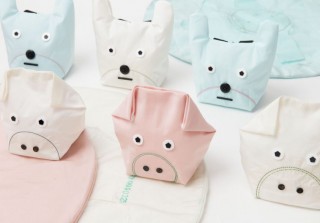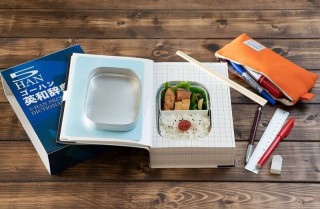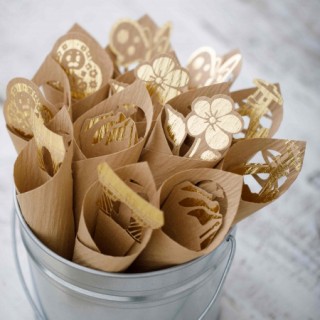Loading
Search
▼ Waste Not Want Not In Japanese Design
- Category:Other
For those hoping to make being more environmentally conscious an upcoming New Year’s resolution, this month’s On: Design introduces a few Japan initiatives that look into repurposing waste in a novel way.
But Newsed — a portmanteau of “new” and “used” — has become a particularly successful brand in Japan.
Featuring collaborations with designers and artists, its products have appeared in museum shops, including the National Art Center Tokyo’s SFT, and various design boutiques, while it also organizes its own popup stores in Japan.
This column has previously mentioned Kouzou Plamo, a structural model kit made from leftover architectural canvas, but there is so much more to Newsed’s oeuvre. Items range from the minimalistic — such as Hiroyuki Morita’s Tenban Trays carved out of old school desks and Akira Mabuchi’s Hundo paperweight stack of metal offcuts — to Konpeito Design’s vibrant saddle suit bicycle seat covers made from surplus wet-suit fabric, and Minna’s geometric factory leftover acrylic accessories.
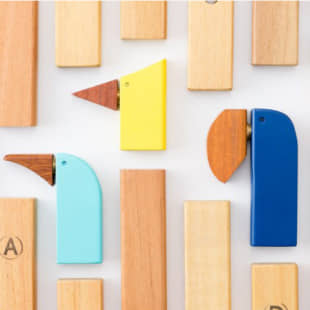
A host of materials are used: leather scraps, leftover tent fabric, old tarpaulins, discarded car airbags and metal, wood, even chopstick offcuts. Sometimes, new products retain the original shapes of the scrap materials, such as Takaaki Kamei’s Tone of Life clock made of the round offcut fiberboard pieces from speakers.
Other times the material takes on a new form, such as Tupera Tupera’s adorable air-bag pig and bear pouches. Most of the time, the items allude to its material origins, such as B6 Studio’s Bird Call sound toy, which is made from unwanted wooden xylophone parts from instrument workshops.
Oogiri-Insatsu (Oogiri-Print) is an unusual project, born from CMYK, a creative initiative of the All Japan Federation of Printing Industry Associations and its PR company. Whether it’s producing practical products from scrap is debatable, the humor involved is unquestionable. After all, it takes its name Oogiri from a Japanese genre of repartee comedy. Oogiri-Insatsu looks to Twitter for inspiration and amusingly responds to tweets by making an item from scrap material, all salvaged from the printing industry.
For example, its Project 1 is a bento box embedded inside what looks like a reference dictionary. Why? Because someone tweeted that they would like to eat lunch during class without being noticed. The dictionary cover is printed with “5-Han Secret Hayaben Dictionary” — a play on the words “gohan” (“rice”) and “hayaben” (early lunch). Don’t worry, a dictionary isn’t actually destroyed. Instead, the tome’s pages, which hide the bento box, are made from discarded graph paper.
Other projects include note pads made from paper napkins for cafe doodlers, and a DIY typeface “design kit” cut from an old calendar and inspired by a fan of the handmade signs often seen at JR train stations.
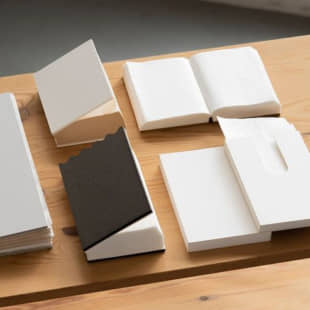
There are currently nine items, created by four different printing companies, and all are available to purchase via contact links on the Oogiri-Insatsu website. These are strange creations, but it goes to show that recycling can fuel the imagination.
Selected by the local government in 2015 as an initiative to help revitalize the 2011 tsunami-struck areas in Ishikawa Prefecture, Atte collaborated with the local forestry association to develop an aroma room spray derived from discarded wood chippings. Its newest products, Atte Chouchou shoe deodorizers, are also made from chippings, this time processed into recycled paper. Creatively directed by Hidefumi Nomura, Atte Chouchou is a cute idea that emphasizes both the scent and antibacterial properties of Ishikawa’s Noto Hiba cypress wood. It rolls into a cone shape and is laser cut to feature a design motif in its center. Just pop it into a shoe and let its natural qualities deodorize.
There are various Ishikawa-inspired designs, each accented in gold foil, ranging from a simple flower or butterfly to iconic structures, such as Kanazawa Station’s Tsuzumimon gate and the stone lantern in Kenrokuen garden.
There’s also a plain one that you can draw on or write a message in as a card or gift. All are priced at ¥880 per pair and come with a flat-packed paper stand for when not in use. Although these are biodegradeable and are not artificially fragranced or enhanced, Atte say that they can last around six months if dried in sunlight, before they start to lose shape, making them not only environmentally friendly, but also economical.
New used favorites
Kenelephant — a small products company with several brands of souvenir miniatures, vinyl figures and artists’ goods — also oversees upcycling initiatives that create particularly novel goods. One interesting project, Recycle Standard, which introduces a raw scrap material online and then follows it up with the release of inventive products created from it, has laid low for a couple of years.But Newsed — a portmanteau of “new” and “used” — has become a particularly successful brand in Japan.
Featuring collaborations with designers and artists, its products have appeared in museum shops, including the National Art Center Tokyo’s SFT, and various design boutiques, while it also organizes its own popup stores in Japan.
This column has previously mentioned Kouzou Plamo, a structural model kit made from leftover architectural canvas, but there is so much more to Newsed’s oeuvre. Items range from the minimalistic — such as Hiroyuki Morita’s Tenban Trays carved out of old school desks and Akira Mabuchi’s Hundo paperweight stack of metal offcuts — to Konpeito Design’s vibrant saddle suit bicycle seat covers made from surplus wet-suit fabric, and Minna’s geometric factory leftover acrylic accessories.

Other times the material takes on a new form, such as Tupera Tupera’s adorable air-bag pig and bear pouches. Most of the time, the items allude to its material origins, such as B6 Studio’s Bird Call sound toy, which is made from unwanted wooden xylophone parts from instrument workshops.
Getting funny ideas
Oogiri-Insatsu (Oogiri-Print) is an unusual project, born from CMYK, a creative initiative of the All Japan Federation of Printing Industry Associations and its PR company. Whether it’s producing practical products from scrap is debatable, the humor involved is unquestionable. After all, it takes its name Oogiri from a Japanese genre of repartee comedy. Oogiri-Insatsu looks to Twitter for inspiration and amusingly responds to tweets by making an item from scrap material, all salvaged from the printing industry.
For example, its Project 1 is a bento box embedded inside what looks like a reference dictionary. Why? Because someone tweeted that they would like to eat lunch during class without being noticed. The dictionary cover is printed with “5-Han Secret Hayaben Dictionary” — a play on the words “gohan” (“rice”) and “hayaben” (early lunch). Don’t worry, a dictionary isn’t actually destroyed. Instead, the tome’s pages, which hide the bento box, are made from discarded graph paper.
Other projects include note pads made from paper napkins for cafe doodlers, and a DIY typeface “design kit” cut from an old calendar and inspired by a fan of the handmade signs often seen at JR train stations.

Nothing to be sniffed at
Selected by the local government in 2015 as an initiative to help revitalize the 2011 tsunami-struck areas in Ishikawa Prefecture, Atte collaborated with the local forestry association to develop an aroma room spray derived from discarded wood chippings. Its newest products, Atte Chouchou shoe deodorizers, are also made from chippings, this time processed into recycled paper. Creatively directed by Hidefumi Nomura, Atte Chouchou is a cute idea that emphasizes both the scent and antibacterial properties of Ishikawa’s Noto Hiba cypress wood. It rolls into a cone shape and is laser cut to feature a design motif in its center. Just pop it into a shoe and let its natural qualities deodorize.
There are various Ishikawa-inspired designs, each accented in gold foil, ranging from a simple flower or butterfly to iconic structures, such as Kanazawa Station’s Tsuzumimon gate and the stone lantern in Kenrokuen garden.
There’s also a plain one that you can draw on or write a message in as a card or gift. All are priced at ¥880 per pair and come with a flat-packed paper stand for when not in use. Although these are biodegradeable and are not artificially fragranced or enhanced, Atte say that they can last around six months if dried in sunlight, before they start to lose shape, making them not only environmentally friendly, but also economical.
- January 4, 2020
- Comment (0)
- Trackback(0)


